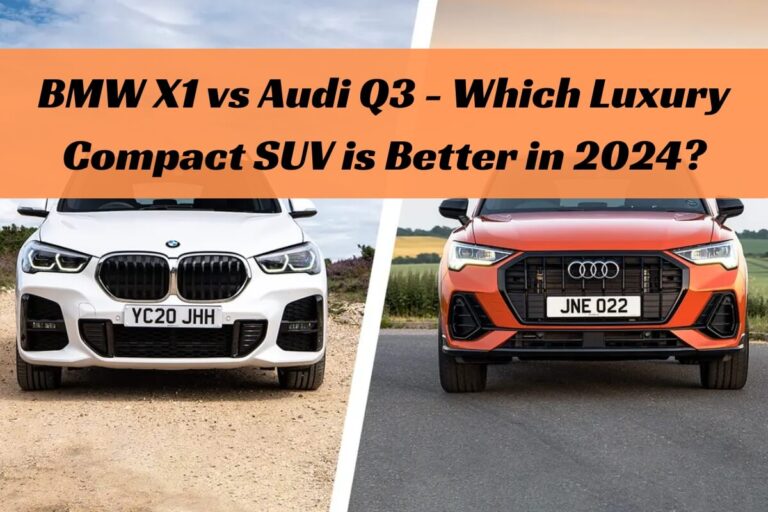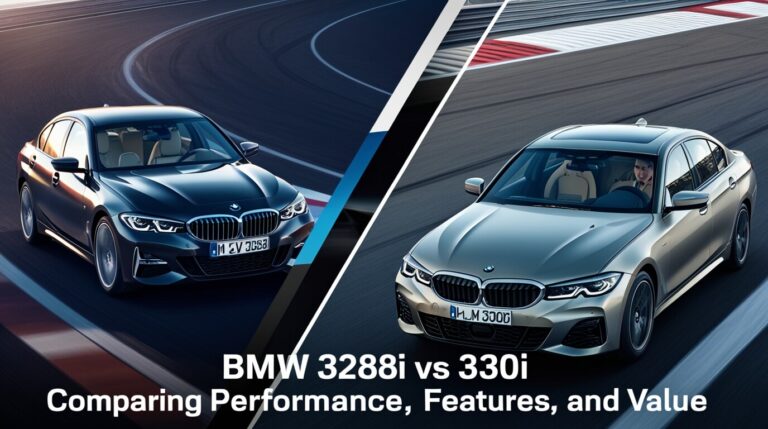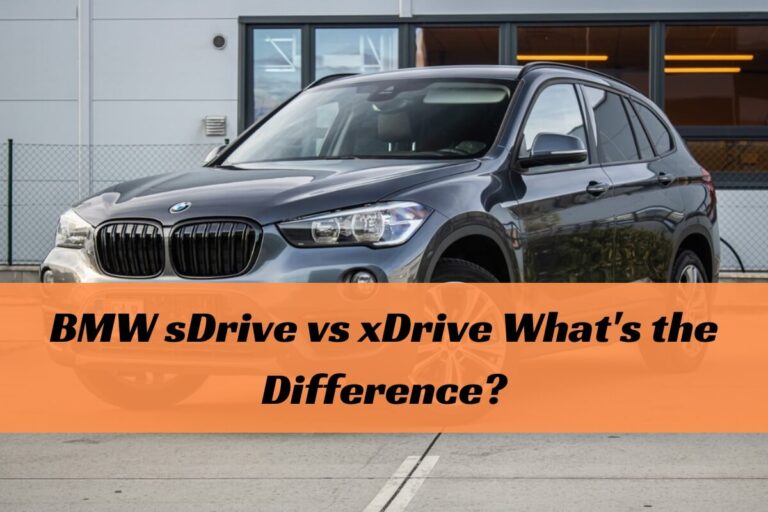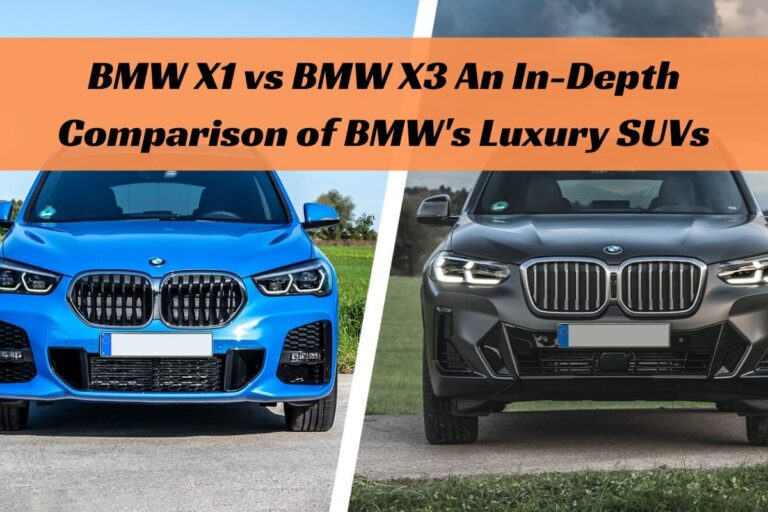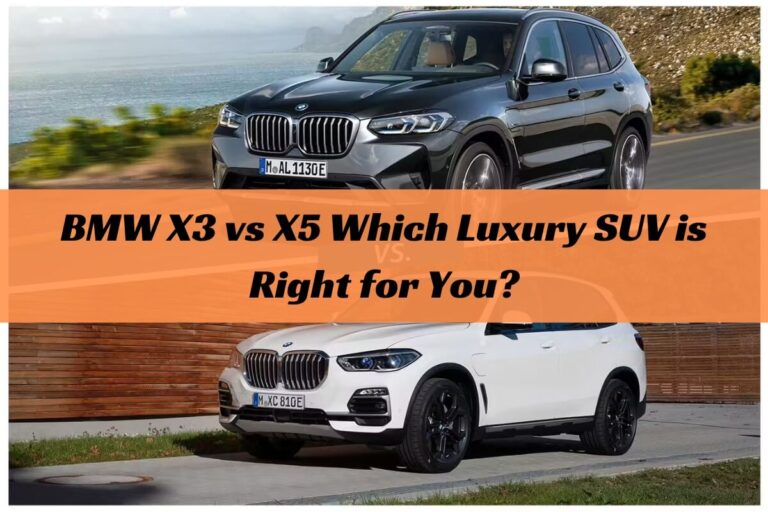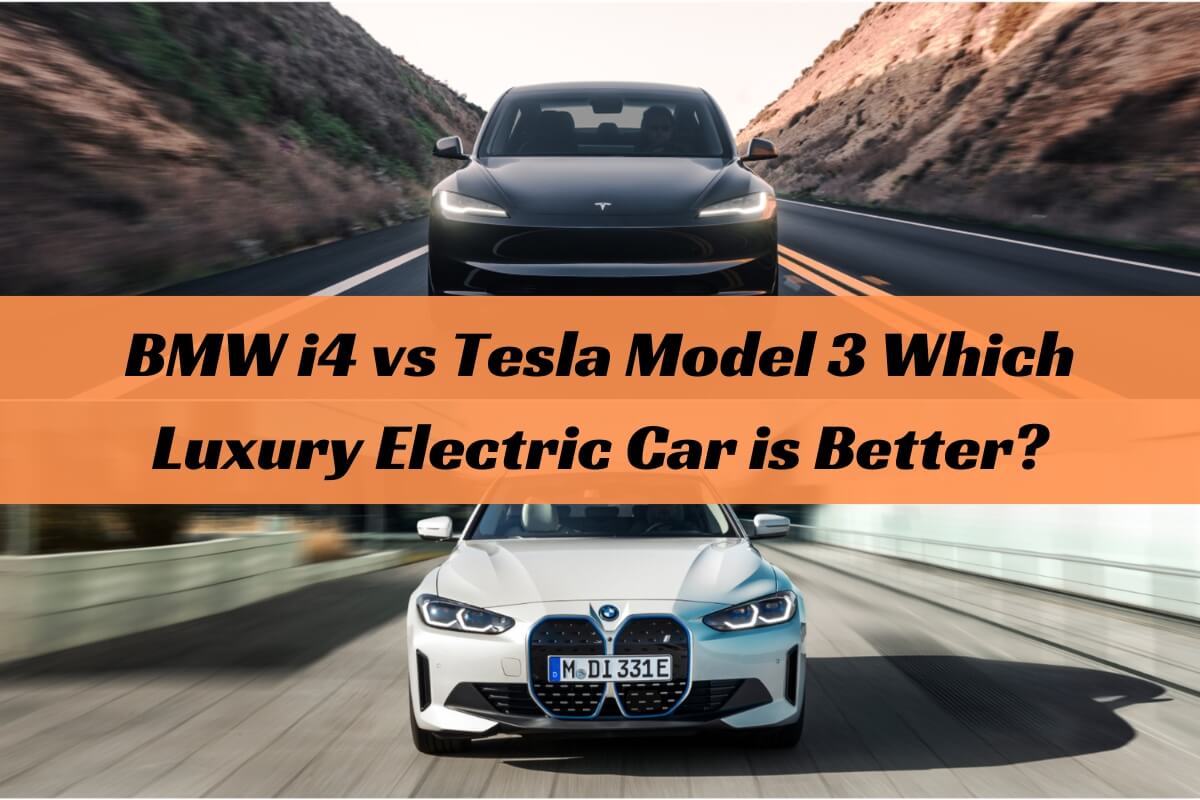
Note: This article may contain product recommendations and affiliate links for which I may receive compensation. Affiliate relationships do not impact my recommendations.
The electric vehicle market is heating up, with legacy automakers and upstart companies alike vying to capture the imagination (and dollars) of car buyers seeking an electrified driving experience. Two models at the forefront of this charge are the BMW i4 and Tesla Model 3 – both representing their respective brands’ bids to deliver a premium electric sedan experience.
But which one reigns supreme – the tech-laden innovator from Tesla or the performance-bred stalwart from BMW?
The better electric luxury sedan between the BMW i4 and Tesla Model 3 is the Model 3, thanks to its blistering straight-line performance, futuristic minimalist interior, over-the-air updates, and better overall value proposition despite being the more affordable of the two.
This detailed comparison will examine every facet of these two compelling EVs, including their design philosophies, performance capabilities, tech features, pricing structures, and overall ownership experiences. By the end, you’ll have a clear picture of which luxury electric vehicle – the BMW i4 or Tesla Model 3 – better suits your specific needs and preferences.
Design and Styling
When it comes to exterior styling, the BMW i4 and Tesla Model 3 take vastly different design approaches that align with their respective brand identities.
Exterior Design
The BMW i4 maintains the traditional BMW design language, sporting the brand’s iconic kidney grille, long hood sculpting, and taught, sporty bodysides. While unmistakably a BMW, the i4 incorporates some modern EV design cues like its blanked-off grille, sleek LED lighting elements, and flush door handles. Overall dimensions are in the midsize sedan territory, measuring 188.3 inches long, 72.9 inches wide, and 57 inches tall.
In contrast, the Tesla Model 3 exemplifies the company’s distinctive aesthetic with its smooth, unadorned bodywork, flush glass surfaces, and conspicuous lack of front and rear overhangs. The Model 3’s sleek silhouette and abbreviated trunk give it a futuristic, aerodynamic look perfectly in step with its electric powertrain. Size-wise, it’s a bit more compact than the i4 at 184.8 inches long, 72.8 inches wide, and 56.8 inches tall.
Interior Design and Space
Differing exterior philosophies extend to the cabins, with the BMW i4 sporting a more traditional premium car interior layout with a freestanding curved display, integrated HVAC vents, and familiar control placements like BMW’s iDrive controller. Material quality is excellent, with upscale leather and wood trims. The i4 provides ample passenger space, though the sloped roofline cuts into rear headroom slightly.
The Tesla Model 3 takes the opposite tact with its starkly minimalist cabin dominated by a massive 15-inch center touchscreen that controls virtually every vehicle function. Besides the obligatory steering wheel and pedal assemblies, there are almost no other interior buttons or switches – a polarizing design ethos. While material quality lags the BMW, the Model 3 has superior rear headroom thanks to its taller glasshouse. Rear legroom and cargo capacity are slightly better as well.
Both vehicles seat five and offer a solid balance of room and amenities, but their interior executions epitomize the contrasting brand personalities – the BMW leans towards familiarity and tradition, while Tesla embraces a stripped-down futurism.
Performance and Driving
With their premium badges and electric power, both the BMW i4 and Tesla Model 3 promise scintillating performance and a dynamic driving experience, albeit achieved through differing means.
Electric Powertrains and Acceleration
The BMW i4 lineup offers three powertrain configurations:
- i4 eDrive35 – Single rear motor, 281 hp, 295 lb-ft, 0-60 mph in 5.8 sec
- i4 eDrive40 – Single rear motor, 335 hp, 317 lb-ft, 0-60 mph in 5.7 sec
- i4 M50 – Dual motors (all-wheel drive), 536 hp, 586 lb-ft, 0-60 mph in 3.7 sec
The range-topping M50 packs ferocious thrust to humble high-performance gasoline sports cars. Even the base eDrive35 provides thrilling acceleration by ordinary standards.
Not to be outdone, the Tesla Model 3 offers:
- Standard Range – Single motor, 283 hp, 307 lb-ft, 0-60 mph in 5.8 sec
- Long Range – Dual motors (AWD), 346 hp, 389 lb-ft, 0-60 mph in 4.2 sec
- Performance – Dual motors (AWD), 462 hp, 471 lb-ft, 0-60 mph in 3.1 sec
The feisty Model 3 Performance positively demolishes the 0-60 sprint with its blistering hustle. Even the Long Range model’s acceleration numbers are extremely potent.
Driving Dynamics and Handling
While both pack a performance punch, they achieve it through very different driving experiences:
The BMW i4 retains the familiar sporting character expected of BMW’s performance models. The steering is precise and communicative, body motions are well-controlled, and the overall handling balance is neutral and composed – a legitimate driving enthusiast’s car. However, the i4’s chassis can feel a bit heavy and inert when pushed hard.
By contrast, the Tesla Model 3’s point-and-squirt acceleration is mind-bendingly quick, made even more dramatic by the complete absence of sound and fury. However, the steering is overly light and numb, and there’s noticeable body lean in hard corners. The Model 3 is an absolute thrill in a straight line but not quite as capable as the i4 when roads turn twisty.
So while the Tesla has the ultimate bragging rights for stoplight heroics, the BMW delivers a more engaging, confidence-inspiring driving experience overall.
Battery Range and Efficiency
Powertrain performance only tells half the story – an electric vehicle’s range and efficiency are equally crucial measures of its real-world capability.
The BMW i4 models are powered by battery packs ranging from 70.2 to 81.5 kWh in capacity. EPA-rated ranges are:
- eDrive35 – 256 miles
- eDrive40 – 301 miles
- M50 – 271 miles
In independent testing, the i4 eDrive40 achieved around 280 real-world miles on a full charge, which is respectable if not class-leading.
Meanwhile, the Tesla Model 3 relies on battery packs sized from 57.5 to 82.1 kWh, with EPA ranges of:
- Standard Range – 272 miles
- Long Range – 358 miles
- Performance – 315 miles
Third-party testers have recorded over 330 miles of real-world driving in the Long Range model – an exceptional result that handily beats the i4.
When it comes to efficiency, Tesla has demonstrated an edge as well, with the Model 3 Long Range achieving the gasoline equivalent of 132 MPGe combined compared to 109 MPGe for the i4 eDrive40.
Both vehicles can charge at up to 250kW from a DC fast charger, with the BMW taking around 35 minutes to charge from 10-80% state of charge versus 30 minutes for the Tesla.
So while the BMW offers perfectly viable range and efficiency, the Tesla Model 3 is the clear winner here thanks to its segment-leading driving distances and superior powertrain efficiency.
Tech Features and Infotainment
Modern premium vehicles aren’t just about driving dynamics – they also need to deliver on the cutting-edge tech features car buyers have come to expect. The BMW i4 and Tesla Model 3 both bring futuristic infotainment and driver assistance functionality to the table, albeit in distinctly different flavors.
Infotainment Systems
The BMW i4 features the brand’s latest iDrive 8 infotainment system, displayed on a crisp 14.9-inch central touchscreen complemented by a 12.3-inch digital instrument cluster. While visually slick and packed with functionality, iDrive still maintains hard button controls for key functions like climate control. Wireless Apple CarPlay and Android Auto are standard.
On the other hand, the Tesla Model 3 takes an uncompromising approach with its monolithic 15-inch center touchscreen that controls virtually every vehicle function and setting. The interface is slick and responsive, with a modern design aesthetic. However, the lack of physical buttons can make simple adjustments cumbersome at times. The Model 3 also lacks Android Auto compatibility, though it does support Apple CarPlay.
Where Tesla has the upper hand is its ability to download over-the-air software updates that can give the Model 3 new functionality and enhancements over time. BMW has been slower to adopt widespread OTA updates.
Driver Assistance and Safety Tech
Both vehicles come loaded with a full suite of advanced driver aids like:
- Adaptive Cruise Control
- Lane Keeping Assist
- Automatic Emergency Braking
- Blind Spot Monitoring
- Rear Cross-Traffic Alert
The Tesla Model 3 kicks things up a notch with its Autopilot semi-autonomous driving system that enables auto lane changes, self-parking capabilities, and a Summon feature to autonomously retrieve your car from a parking spot or garage. When subscription-based Full Self-Driving is enabled, Autopilot can even navigate on Autopilot on most roads.
The BMW i4 counters with its own Extended Traffic Jam Assistant that enables hands-free driving on divided highways at low speeds, but it lacks the Model 3’s breadth of autonomous functionality.
In safety testing, both earned Top Safety Pick+ status from IIHS and 5-star ratings from NHTSA. However, the Model 3’s automated emergency braking system rated as Superior – the highest tier.
So while the i4 packs plenty of safety tech, the Model 3 has the edge thanks to the game-changing capability of Tesla’s Autopilot.
Pricing, Trims and Value
When it comes to cost of entry and overall value, there are some clear delineations between the BMW i4 and Tesla Model 3. As you’d expect from the prestige German brand, the i4 carries a higher starting price point.
Model Lineup and Pricing
The BMW i4 lineup consists of:
- i4 eDrive35 – $51,400
- i4 eDrive40 – $55,900
- i4 M50 – $66,900
Adding common options like premium paint, wheels, driver assistance packages, etc. can easily push an i4 M50 past the $70,000 mark.
In contrast, the Tesla Model 3 is more affordable with its trim levels:
- Standard Range Plus – $43,990
- Long Range – $49,990
- Performance – $59,990
Even a fully loaded Model 3 Performance with every available option tops out around $65,000 – undercutting the i4’s upper trims.
Cost of Ownership Considerations
Over the first 5 years of ownership, both vehicles will require fairly low expenditures on “fuel” – the Model 3 costs an estimated $4,700 to charge, versus $5,200 for the i4 based on average electricity rates. With no gasoline required, they both provide big savings over combustion engine luxury sedans.
Scheduled maintenance costs should be minimal as well thanks to EVs’ relatively simple powertrain designs and fewer consumables like oil, filters, etc. Tesla has the edge in not requiring any scheduled service appointments.
Where BMW regains some ground is in superior residual values and depreciation estimates. Experts predict the i4 will retain around 50-55% of its value after 5 years versus 40-45% for the Model 3, which could offset some of that higher initial MSRP.
Overall, while the i4 carries a loftier sticker price, the lower cost of entry for the Model 3 along with its slightly lower operating costs means it delivers a better bang for the buck in terms of outright value.
Which One Should You Buy?
In the battle of BMW i4 vs Tesla Model 3, there is no definitively “better” electric luxury sedan. Each delivers on the core promise of an entertaining, futuristic driving experience blended with the prestige and amenities expected from a premium-badged vehicle.
The BMW i4 plays to BMW’s traditional strengths with impeccable chassis tuning for dynamic driving engagement, a premium cabin ambiance with familiar BMW design cues, and a powerful yet refined powertrain experience. It’s the pick for those prioritizing an involving driving character.
However, the Tesla Model 3 counters with straight-line acceleration simply untouchable in this class, a cleverly packaged and spacious interior, cutting-edge autonomous driving capability, and an overall lower cost of ownership. Its futuristic interior and exterior design may be polarizing, but there’s no denying the potency and value proposition of this disruptive EV sedan.
For driving enthusiasts with the budget for a premium sport sedan, the balanced and capable BMW i4 could be the smarter pick. But for those seduced by bleeding-edge tech and electrifying performance at a more affordable price point, the Tesla Model 3 is the one to beat in this emerging electric luxury segment.
So which futuristic four-door will it be – the proven premium pedigree of the Ultimate Electric Driving Machine, or the mind-warping acceleration and Silicon Valley wow factor of Tesla’s pioneering upstart? No matter which you choose, both the BMW i4 and Tesla Model 3 deliver an electrifying glimpse into the luxury vehicle landscape of tomorrow.

